
Handwriting practice books are the best way to improve your fine motor skills in childhood.
Having good handwriting skills is an essential activity and developmental task for kids. Through their handwriting, kids can express themselves and communicate. That is why it is crucial to help kids improve their penmanship and writing legibility early.
What other way to do it better than to help them practice? Handwriting practice books are excellent tools and help guide children in their journey. They support literacy and help teach kids how to form and join letters to develop neat handwriting while assisting them to work on speed, letter, and word spacing, letter sizing, and word fluency.
Quick Facts About Handwriting
Handwriting displays one’s personality traits, including attitude, emotional fortitude, creativity, and ability to communicate.
Experts say that illegible handwriting is a problem for almost one-third of school going children. In many cases, the problem is so severe that it hampers their ability to perform well in academics. The root of the problem often lies in the fact that these children do not practice writing enough.
About 90% of the work done by students in a particular class is completed by hand.
What Are The Most Important Factors When Choosing a Handwriting Practice Book?
- Level of difficulty
- Size of the book
- Type of paper
There are many different factors to consider when choosing a handwriting practice book. The most important factors are the level of difficulty, the size of the book, and the type of paper used.
If you are a beginner, it is important to choose a book that starts with basic letters and gradually builds up to more complex letters. The size of the book is also important, because you will want enough space to practice each letter without running out of room.
When it comes to handwriting practice books for kids, size really does matter. In order for the child to get the most out of the book, it needs to be large enough for them to comfortably write in. If the pages are too small, they may not be able to fit their writing on the page and will become frustrated. This can lead to them giving up on practicing their handwriting.
The type of paper used is also important. Some books use recycled paper, which can be difficult to write on because it is rough and absorbent. Other books use smooth paper that makes writing easier.
If you are a teacher, parent, or therapist and want to help a kid with their handwriting, the books below will significantly help.
What Are Some Good Handwriting Practice Books Based On The Above Criteria?
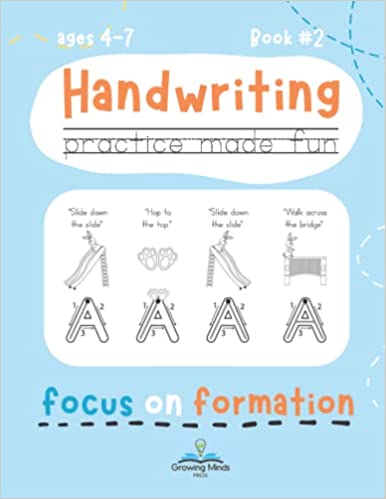
Handwriting Practice Made Fun, by Growing Minds Press (2022)
Kids who are learning how to write need to know about letter and number formation. These are vital components for building a solid handwriting foundation.
In this workbook, you find essential step-by-step instructions about writing with movements familiar to kids. They are presented in a stroke-based teaching method based on developmental progression. This is how your child will be able to progressively use the skills learned in the book even as they grow older.
Through this book, kids will be able to practice saying different phrases as they trace the letters in them and do letter reviews. They also get to write using colored pencils or crayons, and the best part about it is that they get some joke time to make practice more fun. The publisher also offers video guides as companion. They bring the handwriting movements taught in the workbook to life and allow children to practice handwriting through kinesthetic movement, which reinforces learning.
Growing Minds Press focuses on establishing correct handwriting formation to help learners eventually be able to write numbers and letters with automaticity. If you want to develop your child’s handwriting skills with different material, the publisher also has a wide range of books on handwriting practice. You can use them with this particular title to assist your child gain other handwriting skills.
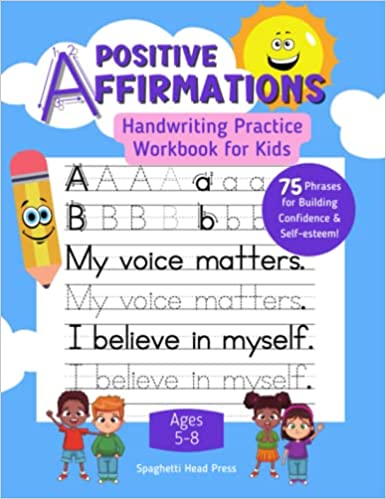
Positive Affirmations Handwriting Practice Workbook for Kids, by Kelly Louise (2022)
This book is an educational workbook for children that teaches how to write while instilling life lessons. It will initially help your child practice writing lowercase and capital letters. But that’s not where the learning ends. The book progresses to help them form or write entire sentences, which are positive affirmations.
As your child practices how to write these affirmative statements, they will build confidence and self-esteem, which are both excellent qualities we want to see our kids have. The statements will also help your child learn how to do healthy self-talk and how they can cope or handle negative thoughts.
Kelly has made writing practice fun with drawing pages and coloring that coordinates with the affirmations in the book. This is an excellent way to develop fine motor skills.
Many kids take hits that often make their self-confidence deteriorate, but the affirmations here will help bring such kids back to feeling good about themselves. Mental health is now a more significant problem even for kids, so help your child reinforce their self-image or esteem with this book as they practice how to write.
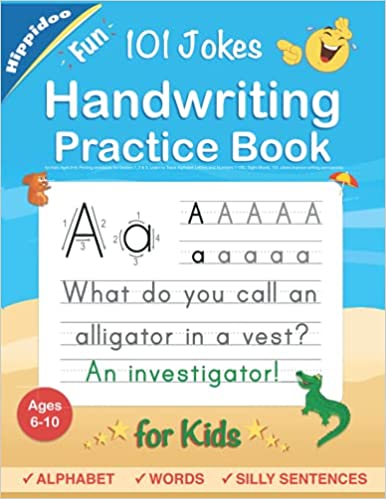
Handwriting Practice Book for Kids Ages 6-8, by Sujatha Lalgudi (2020)
This is a beginner handwriting book to assist kids between ages 6-8 learn how to write. It contains excellently detailed instructions and is built on modern learning strategies. It also has playful drills to make the experience more fun. It is a perfect tracing book, and a good starting book for a kid’s preschool head start.
Sujatha has organized this book in a progressive skill-building manner to assist kids in building confidence for neat writing and improved penmanship.
The book features numbers and number words from one to a hundred and will help your child learn to trace and write the alphabet in lowercases and capitals. It will also help them write sight words and jokes.
Kids get to trace illustrated jokes and write them individually. As they share these jokes with family or friends, they will want to practice even more; that is how they will become better writers. All the writing practice is divided into sections to build progression and skill and develop your child’s confidence.
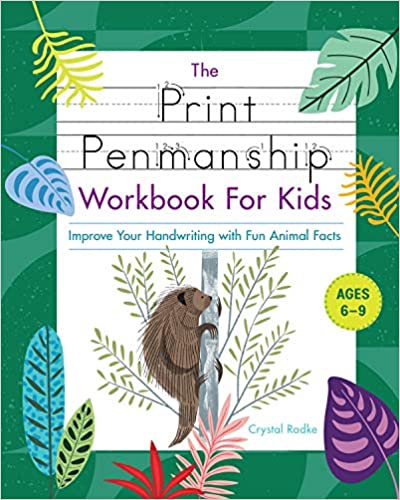
The Print Penmanship Workbook for Kids, by Crystal Radke (2020)
Neat printing takes practice. However, keeping a child occupied with writing drills can be difficult. But with this innovative penmanship workbook, children will learn what good penmanship is about.
They will achieve that as they read and copy words about different animals. This book features fun facts and colorful illustrations about birds, bugs, reptiles, fish, and mammals. Every lesson your kid goes through will feel like a romp within the animal kingdom.
As kids practice, they will build excellent skills. They start by tracing the alphabet and move up to working on how to print whole sentences. All the exercises in the book have been curated to uncover new knowledge, and the full-page pictures for coloring will give your child an opportunity to get more creative during their lessons.
The Print Penmanship Workbook for Kids also has Before and After pages highlighting a kid’s progress and showing how much their penmanship has improved. That way, you can also help your children celebrate their progress. The book goes beyond the repetitive and traditional exercises about writing to make handwriting highly entertaining.

Handwriting Practice for Kids Grade 1-3 Jokes and Riddles, by KennieBStyles Journals (2020)
This workbook will come in handy if you want to keep kids engaged while they work on their printing and handwriting. To make the learning curve more enjoyable, the book has more than seventy-five jokes that kids can trace and write while practicing.
Kids trace the jokes over dotted lines once they have read them and write them in the lines shown. That way, they get helped with complete printing sentences and also how to regulate letter sizes and spacing. Not only will they practice their handwriting, but they will also get to tell the jokes they discover to family and friends. This will increase engagement and a more powerful yearning to practice.
The jokes and riddles are also an excellent way to get a short break from practice for a kid who finds it monotonous. The book also has extra spaces for kids to write their jokes toward the end. It is ideal for kids who have already learned how to write the alphabet but still need practice. It is also a good tool for educators since they can reproduce the sheets for classroom use.
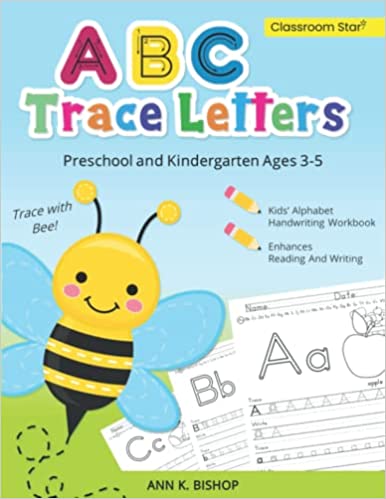
Trace ABC Letters, by Ann K Bishop (2022)
Trace ABC Letters is an alphabet tracing workbook that will assist in preparing children to read and write while supporting fluency. Kids will get to trace and learn how to write the alphabet for letter recognition. The alphabets are done in lowercase and uppercase. They will learn how to form every letter and repeat different motions to create the circle and stick letters.
To achieve that, Ann excellently uses the help of dotted letters and arrows and gives guidelines on how to go about each step. As a child practices the letters, they will also build muscle memory which is a crucial part of handwriting.
This book also features fun maze exercises specifically curated to teach kids how to connect consecutive alphabetical letters. The activity pages help with letter connection, filling in letters and blanks for better alphabet recognition.
As a bonus, Ann has added a section with practice pages and letter skills so that children can showcase their newly learned handwriting skills.
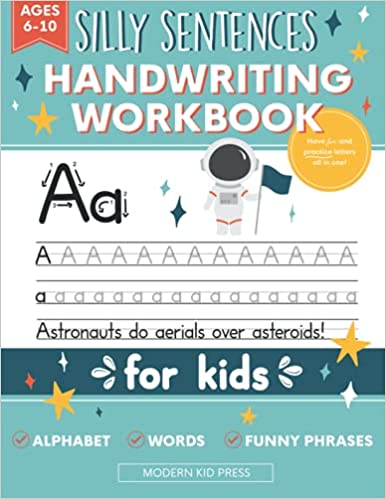
Handwriting Practice Book for Kids (Silly Sentences), by Modern Kid Press (2021)
This silly sentence workbook takes kids through the basic strokes required to help with practicing print handwriting but, most importantly, with a lot of fun. The book contains individual letter practice alongside silly sentences that will keep children learning and laughing. Your child might even want to do extra work from the excitement of being silly. Handwriting practice will be more of a breeze for kids by the time they get to the trivia section. The section is packed with unscrambling, decoding, and word search activities.
This book is ideal for children in the 6-10+ age bracket. It is printed on high-quality paper and is a perfect size that children can carry anywhere to practice. It will be an excellent tool for kids beginning or on a journey to polish their handwriting skills.
Each tutorial is cute and fun and has easy-to-follow step-by-step instructions about writing. The workbook has many practice sheets that give children more practicing options, and the examples are easy to understand.
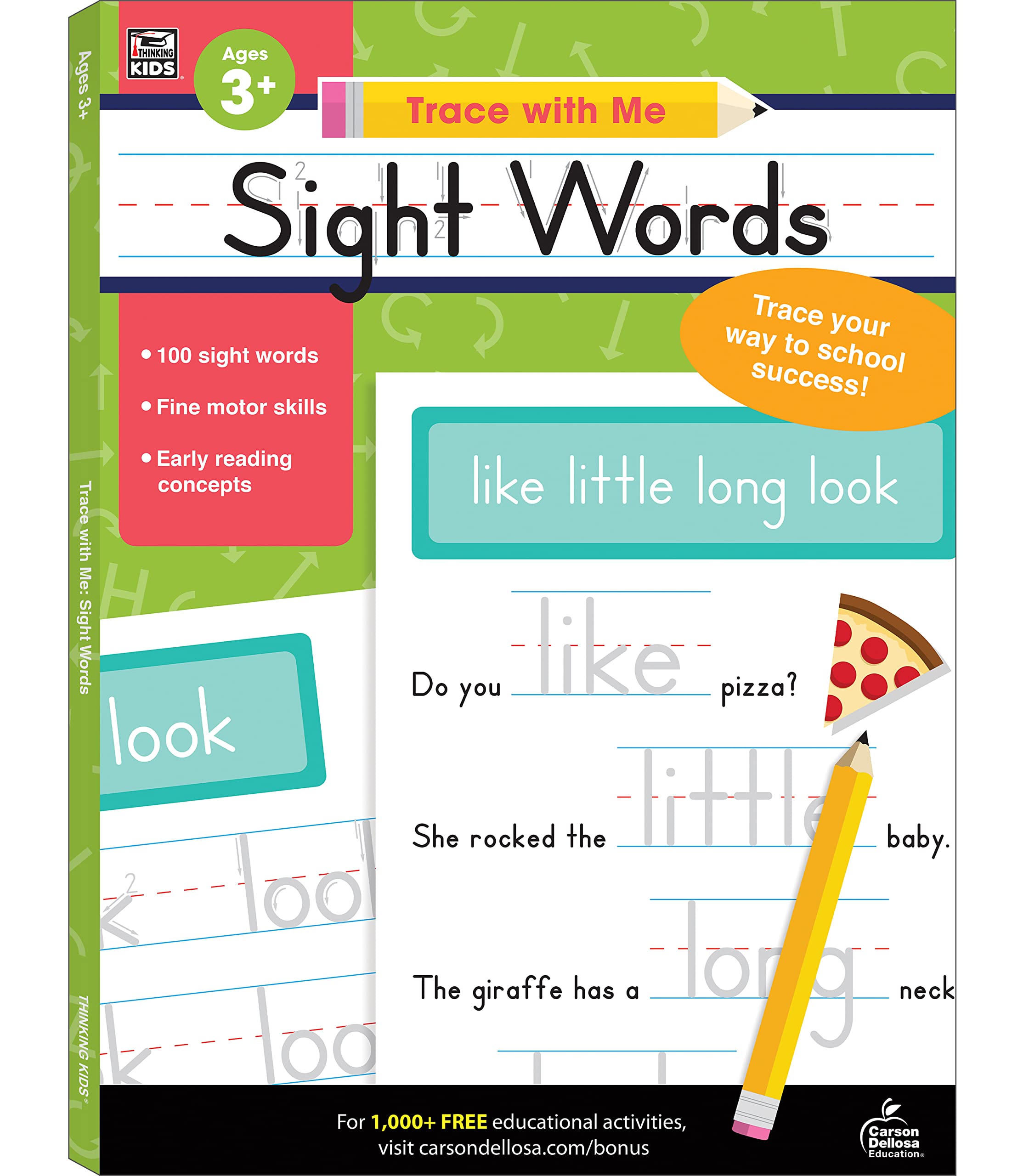
Trace with Me, by Thinking Kids (2018)
Trace with Me helps young learners build their fine motor skills by assisting them in learning how to trace and write indispensable sight words. The book features engaging writing activities, and young ones will not get bored quickly. It includes full-color practice pages covering beginners’ handwriting skills like writing, tracing lowercase and uppercase alphabetical letters, and tracing over a hundred essential sight words.
Children learn through interactive, hands-on writing exercises. The pages feature detailed instructions for the teacher and student to follow in every new writing task. This book is an essential tool for parents since it will provide added practice, and for teachers, it is an excellent material to incorporate hands-on writing activities.
Regardless of your role in a child’s handwriting practice journey, this book will help them understand things better through the instructions and the answer keys that check on progress.
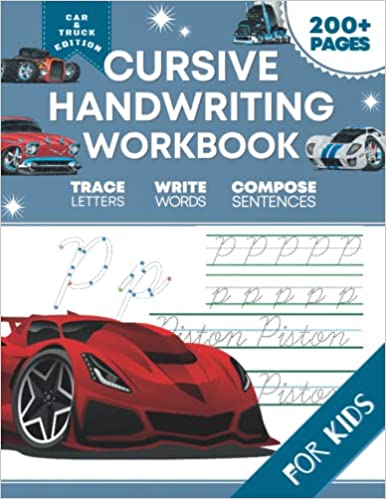
Cursive Handwriting Workbook for Kids, by Optimistic Pixel (2022)
Are you a teacher or parent who teaches cursive writing to kids? If so, help them build their confidence with this workbook. It teaches the basics of cursive writing while assisting young ones to learn positive words and unicorn wisdom.
This unicorn edition has different tactics on how to perform better on spelling and reading tests. It is appropriate for kids of all ages to trace letters and learn the cursive alphabet as they follow every numbered dot.
Once the kids get familiar with the cursive alphabet, they get to be guided on how to connect the letters to form words and build complete sentences. Later on, they can work on the exercise given in the book for building muscle memory and penmanship. Teaching a kid how to control their hand while writing is essential and practice will be even more entertaining with this book.
The book has hundreds of papers to maximize practice. Several studies have shown that those who learn cursive writing score higher in reading and spelling compared to those who can only write in print. So grab this copy to help a kid activate their brain, retain information, enhance their fine motor skills, and become better.

Handwriting Workbook for Kids, by Scholdeners (2021)
This handwriting practice book has a comprehensive, fun, and engaging way to help kids learn to handwrite. It is packed with funny jokes, riddles, and encouraging words that will motivate kids while they work progressively through the book.
The book features three sections. The first one is about letter tracing, and here, kids will learn how to trace and copy letters of the alphabet in capital and lowercase forms until they have mastered the letters.
The second section is about how to write words. It combines the skills a child has gained in section one by allowing them to write a combination of selected simple and complex words. Every page in this section contains a fun joke.
The third and last section is about full sentence construction. Here, kids write complete sentences as they copy the riddles and jokes provided. This book gently guides kids on their handwriting practice from the beginning to the point they can happily and confidently write whole sentences.
Final Thoughts on the above selection of Handwriting Practice Books
Good handwriting is essential for kids to do their homework, take notes and tests, and do other tasks. It helps with brain development, and we must help our kids improve their handwriting for all these reasons and others. The recommended books are excellent starting points and materials for constant kids’ handwriting practice.
Check also our following article for kids (and also for adults):
Top 8 Books Like The Little Prince – Not Just For Children
